For the Northern Hemisphere, spring is here – a time to start packing away winter jackets, and enjoying sunbaking on the deck.
But increasing warmth can also bring fires, and in Siberia and the Russian Far East, the situation is already looking pretty dire.
Russian Emergencies Minister Evgeny Zinichev has said that in Krasnoyarsk, 10 times as much territory was ablaze on April 27 compared to the same time last year, while in Transbaikal it was three times, and in the Amur region it was one and a half times as much.
In the Transbaikal region alone, this amounts to 200,000 hectares burnt – a larger area than the whole island of Maui, Hawaii.
And unfortunately, the cause is likely the worst mix of climate change, and COVID-19 cabin fever.
According to authorities, the fires have originated from a variety of sources, including out-of-control agricultural fires, arson, and untended campfires.
"People self-isolated outdoors and forgot about fire safety rules," says Sergei Anoprienko, head of the federal forest agency Rosleskhoz.
"In some regions, the temperature is already around 30 degrees C [86 degrees F], and people just can't keep themselves in their apartments."
"People rushed outdoors, and as a result we have a surge of thermal points," he added.
NASA's Terra satellite captured images of some of the fires from space on April 27 (below).
 (NASA)
(NASA)
Currently, the area is undergoing unusually hot weather and strong winds, which as we saw earlier this year in Australia is a dangerous combination.
NASA reports that winds on April 23 caused many of the fires used by locals to dry out grass to spread uncontrolled.
"The regions of Kemerovo and Novosibirsk among others have been the hardest hit to date," the NASA release explains. "Nine Siberian regions have been affected by these wildfires. Clouds of smoke have swept across the Siberian landscape."
Scientists have shown that as the global average temperature continues to rise, and we see more and more carbon dioxide in our atmosphere, these wildfires will continue to become on average larger, more dangerous, and more frequent.
We already saw some pretty intense wildfires in Siberia in 2017 and 2019, and London School of Economics geographer Thomas Smith told Earther that Russia currently has 2 million hectares of grassland and forest on fire across the continent – which is not far off the horrific July 2019 figures. And it's only May.
Anoprienko warned that it's very early in the season for numbers like this. He explained that by April 28 last year in TransBaikal, 382,000 hectares had been burnt. This year, the area has already had 477,000 burnt hectares.
This is likely only the start of another intense fire season across the Northern Hemisphere. California has had a drier than average winter, and Europe is already experiencing particularly warm weather.
"An abnormally warm winter, an arid spring, and the human factor have made adjustments to our forecasts,' said Anoprienko.
"In May – June, a dangerous period usually begins in Siberia … We can keep talking about the forecast for a very long time, but the actual fire situation will literally depend on us and you - on how we will behave."
That probably should be a lesson to all of us.
